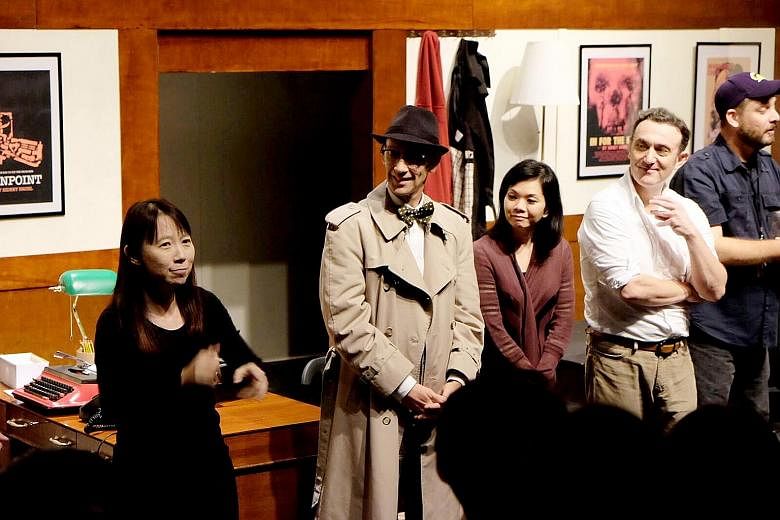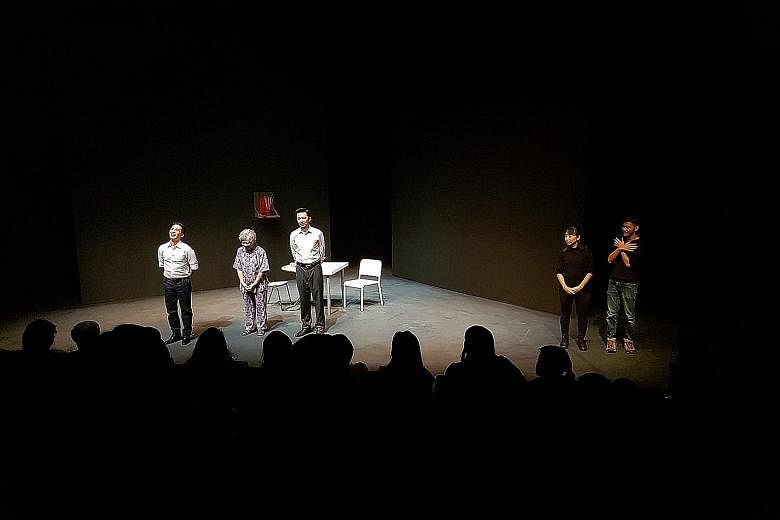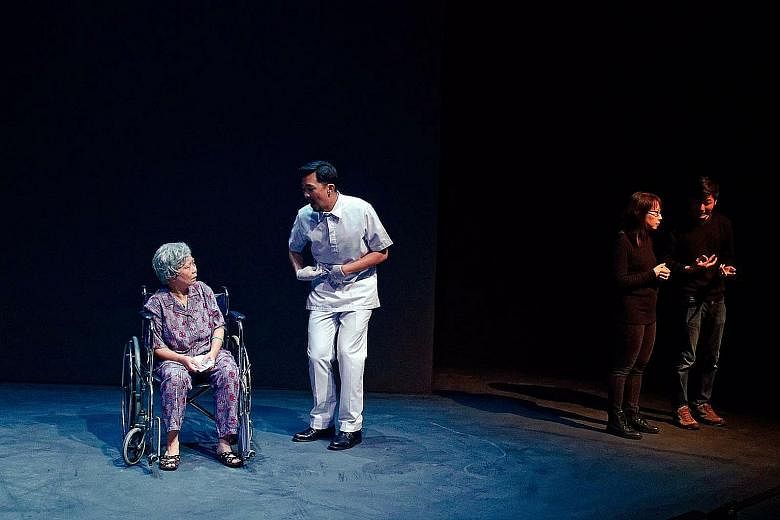When Grandmother Tongue was staged at the School of the Arts in October last year, two figures in black quietly shared the stage with the play's three characters.
As the characters spoke their lines in a mix of English and Teochew, the two figures gestured with their hands.
Ms Claudine Chan, 45, and Mr Teo Zhi Xiong, 25, were not part of the cast but full-time sign language interpreters from the Singapore Association for the Deaf.
While having sign language interpreters ensures that art performances such as plays are accessible to the deaf community, interpretation for them is still sorely lacking, said the association.
Only around six plays or musicals last year were accessible to the deaf community, though three major art events, such as the Singapore Writers Festival, had interpretation.
"Theatre performances are not easily accessible to the deaf community, so working towards a more inclusive society, including theatre, is an area we should look into," said the association in response to queries from The Straits Times.
"The deaf and hard-of-hearing community should be able to enjoy cultural... performances in an accessible format, through the provision of sign language interpreters and subtitles," it added.
Special qualifications are not needed for interpreters in art performances, but the job requires more preparation and experience.
Even for a simple speech, for instance, Ms Chan has to look through it beforehand and do research on unfamiliar terms.
Unlike the usual speech, meaning in artistic works is conveyed through techniques like rhyme, rhythm and wordplay.
When it comes to an art event such as a theatrical play, interpretation is not just about translating the words spoken in the piece, but also capturing its nuances, emotions and rhythm.
To prepare to interpret a play, Ms Chan has to speak to the director and cast, sit in with the cast as they do a reading of the script, and attend rehearsals and the technical run on stage.
-
CAUSES: Know of a group championing a less-known cause? E-mail us at stnewsdesk@sph.com.sg
Ms Chan and Mr Teo said it takes a lot of "homework" before they can translate a play for deaf audiences.
In a joint e-mail reply, they said: "We will first need to understand the piece - the author, his lifestyle, the time and motivation for the piece of work, if possible. Next, we learn about the literal and figurative use of language in the work."
They then formulate ideas about the work's emotional tone or impact, and will seek clarification from the playwright or director, if needed.
With theatrical shows such as Grandmother Tongue, the interpreters use larger signs with less finger-spelling as they are farther from the audience.
During the play, the interpreters have to carefully observe the actions and tone of the performers. They also have to note sound effects which might affect the mood of the audience.
The job often goes beyond just using sign language, and can require the interpreters to be performers in a way. They may have to use body and facial expressions, rhythm through movement and pauses in signing for dramatic effect. They also need to consider the force, size and speed of their signing.
A lot of thought goes into making theatre performances accessible to the deaf community, including where they sit in the theatre.
Mr Teo and Ms Chan noted that there has to be lighting on the interpreters when information is being conveyed. But the lights should not be shining in the eyes of the audience. Warm or cool light is preferred over strong lighting that masks the interpreter's facial features and causes eye fatigue.
Mr Alvan Yap, 40, a freelance writer who is deaf, lamented that he has missed some shows because of the lack of interpretation or subtitles. "I was curious as to what the hype (over some shows) was about and wanted to attend too, but there was no point," he said.
He noted that almost all local English-language theatre productions, like the Dim Sum Dollies, do not provide subtitles or sign interpretation, unlike non-English ones which usually provide subtitles.
Last year, he went to see Ninagawa Macbeth, a retelling of the iconic Shakespeare classic performed in Japanese with English subtitles.
He also caught Lao Jiu The Musical, which was performed in Mandarin with English subtitles.
Mr Yap said he is not expecting sign interpretation to be offered at all events as this would require a lot of manpower. "What I mean is, interpreters should be provided upon request, ideally for art events, and it should be mandatory as a service in hospitals and other essential institutions," he added.
Mr Yap also hopes that public service videos such as those by government agencies and mainstream news clips will have subtitles or captions. Videos used in educational settings such as classrooms or lectures could also have such an option, he added.
Some point out that having sign language interpreters also benefits those who can hear, by helping them to better understand those who cannot hear.
Writer Alfian Sa'at wrote last year on his Facebook page about the presence of sign interpreters at Grandmother Tongue: "I thought about how as much as (the interpreters) were making the play legible for the deaf members in the audience, they were also making the deaf community - with its own deaf culture, its deaf literature - visible to the rest of us."
As for the Singapore Association for the Deaf, its hope is that "seeing an interpreter at work at events should become a norm" in future.
It said: "For hearing people with deaf family members or friends, having an interpreter would mean that they can invite them to the event as well.
"Most importantly, both hearing and deaf people can enjoy and participate in the events together."




